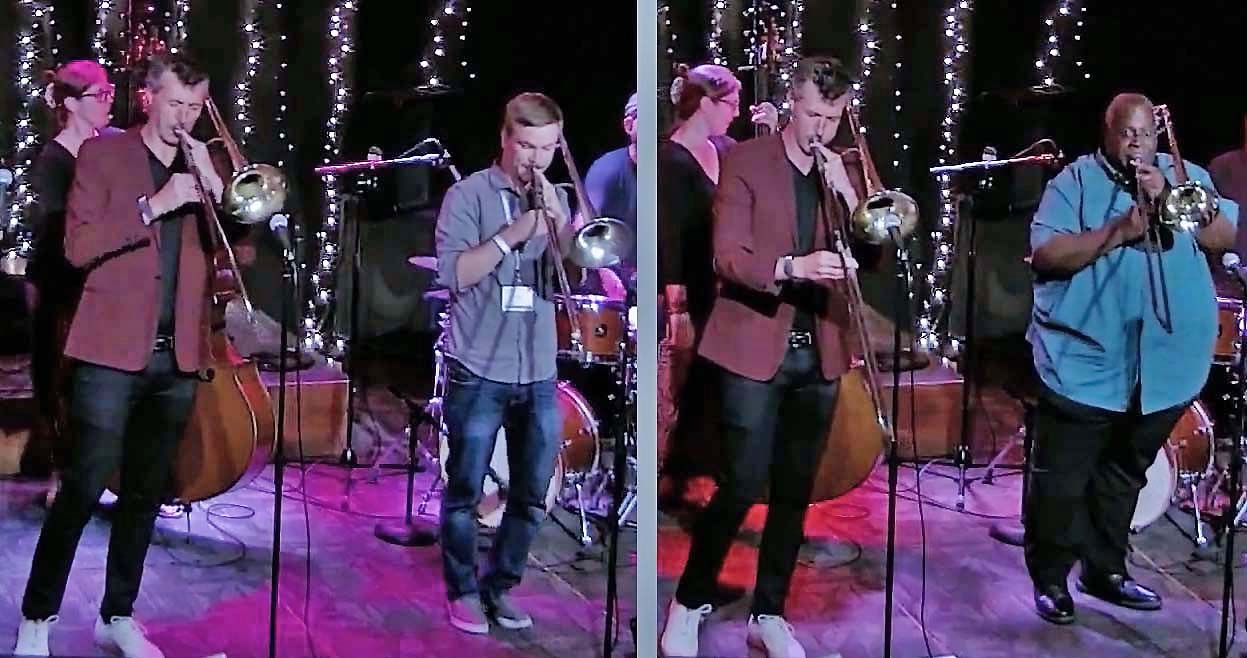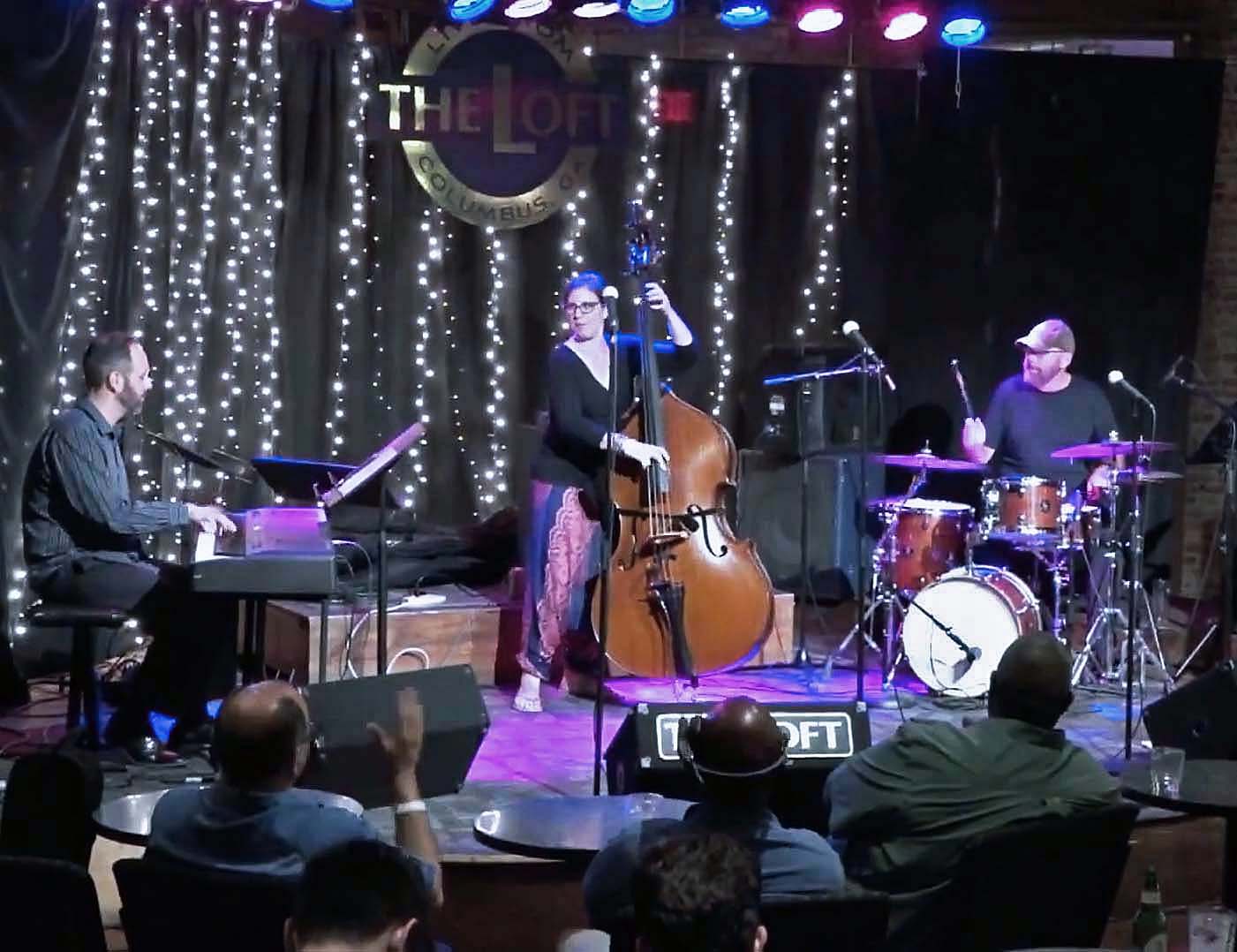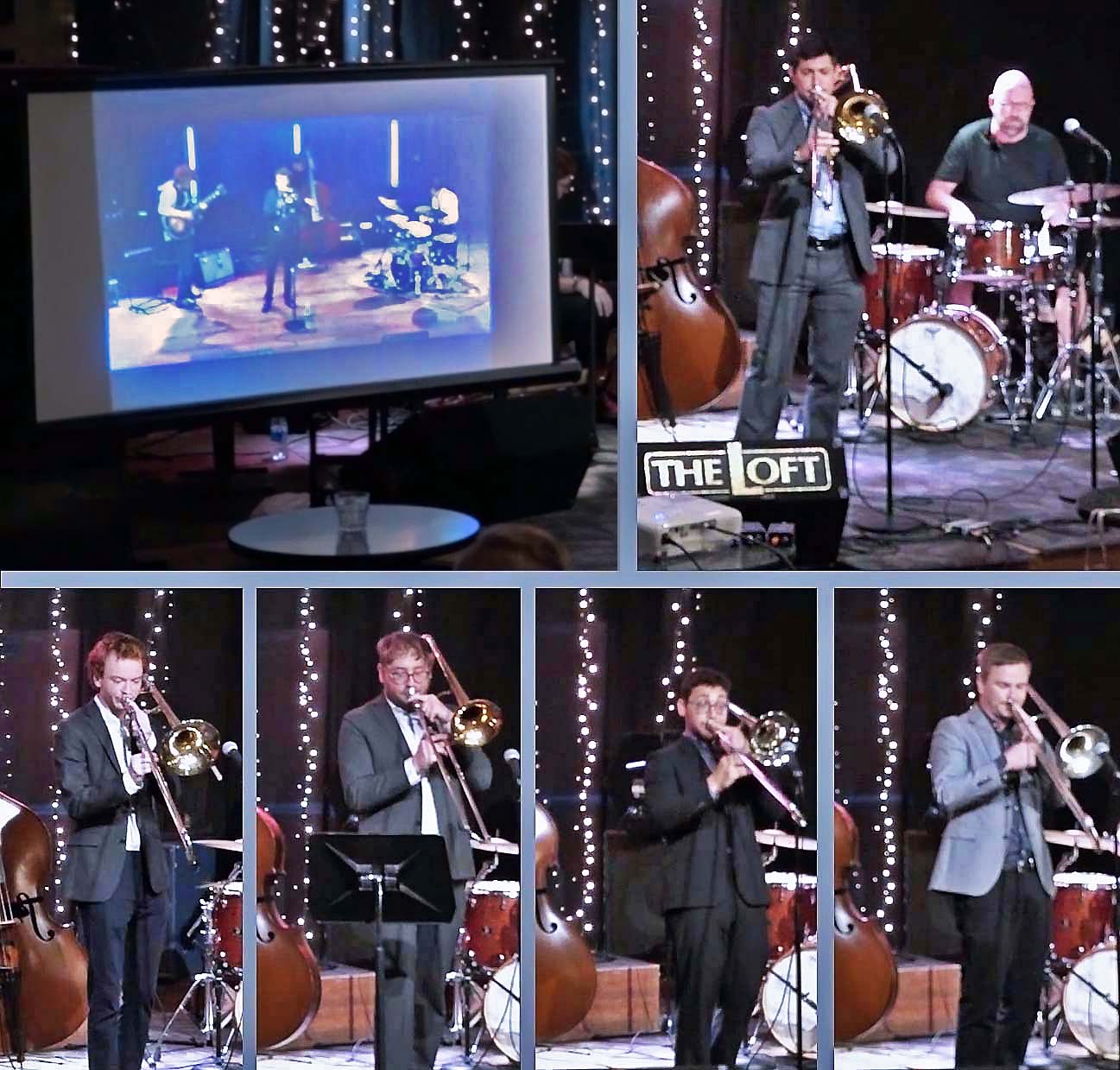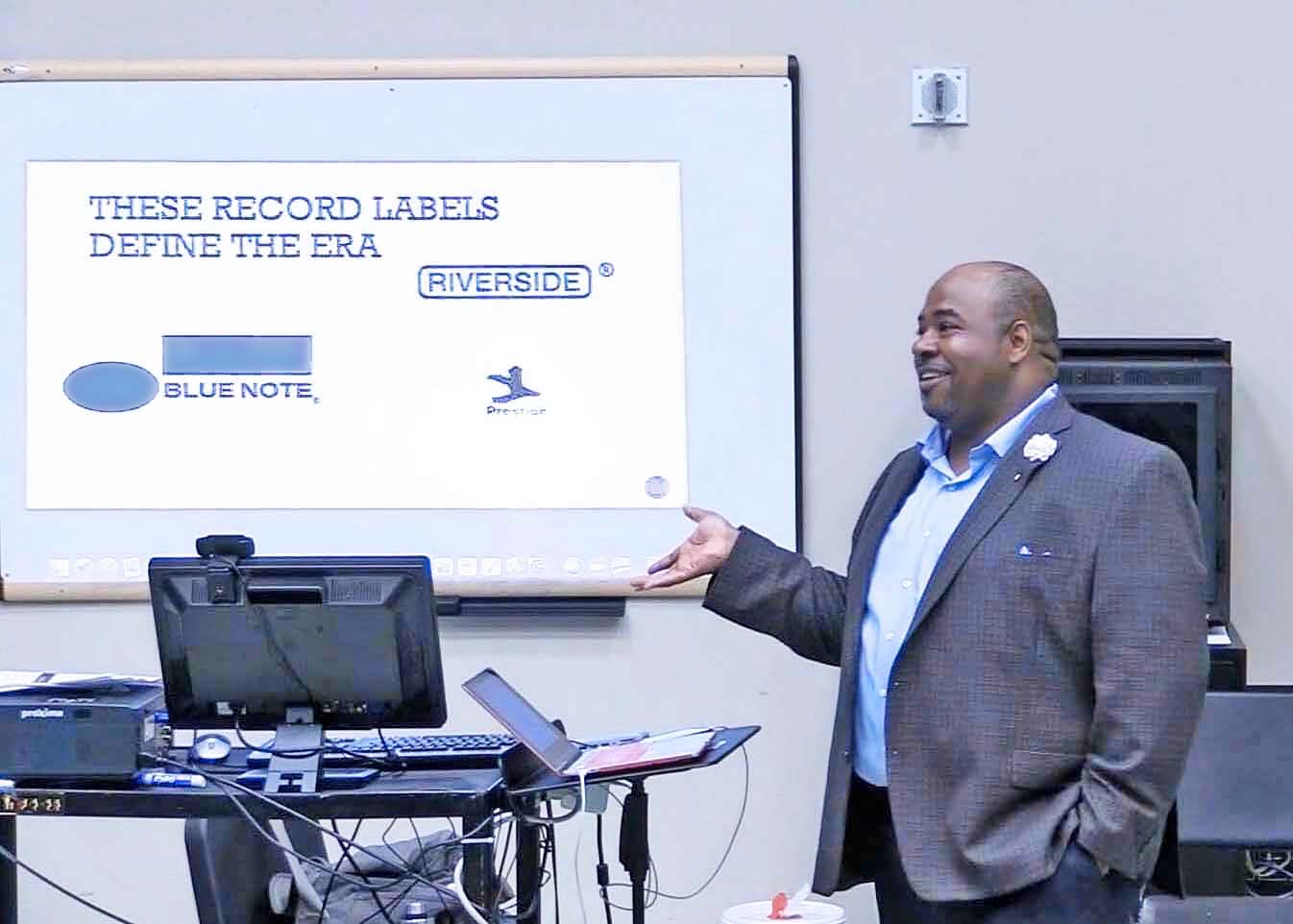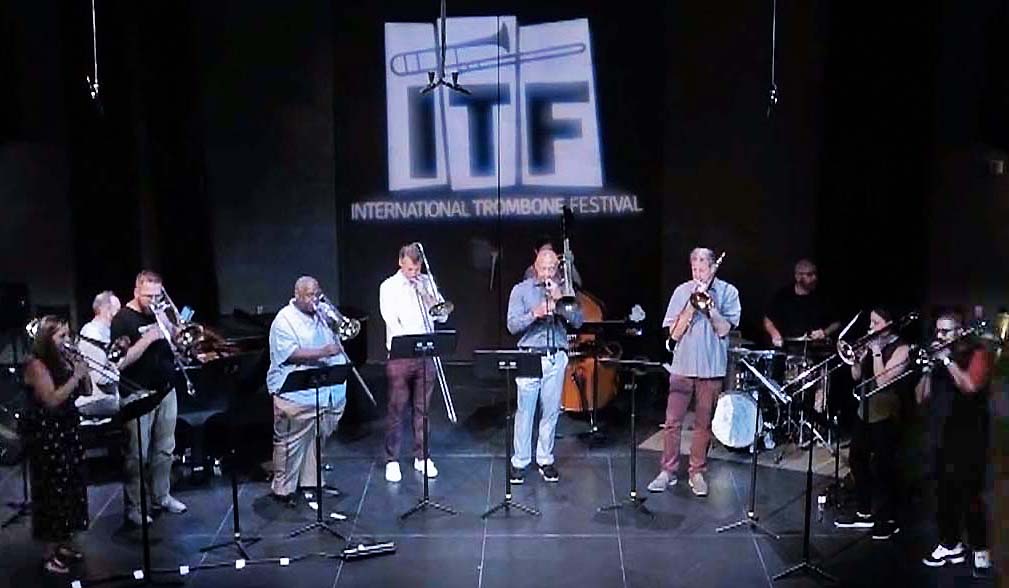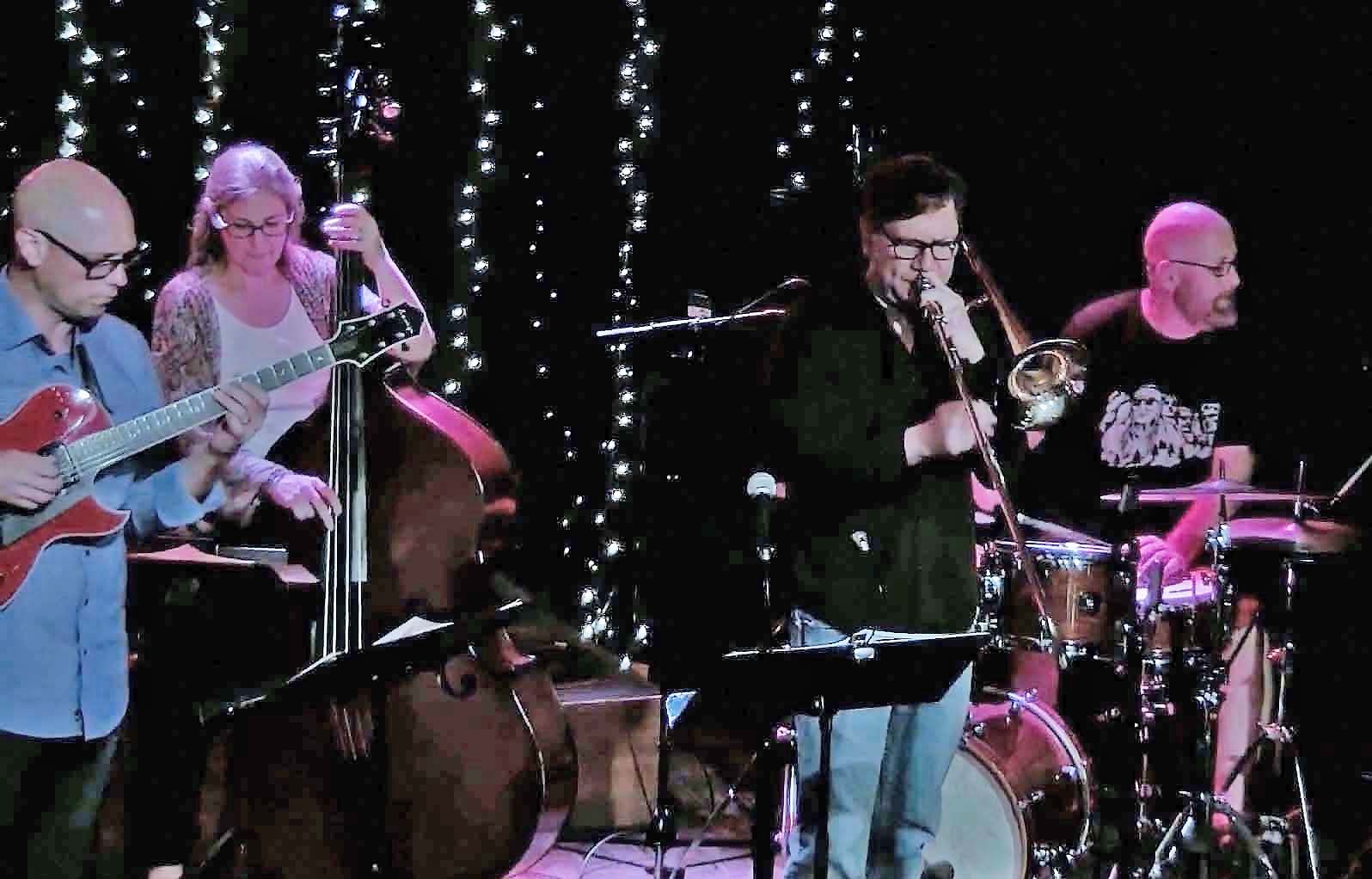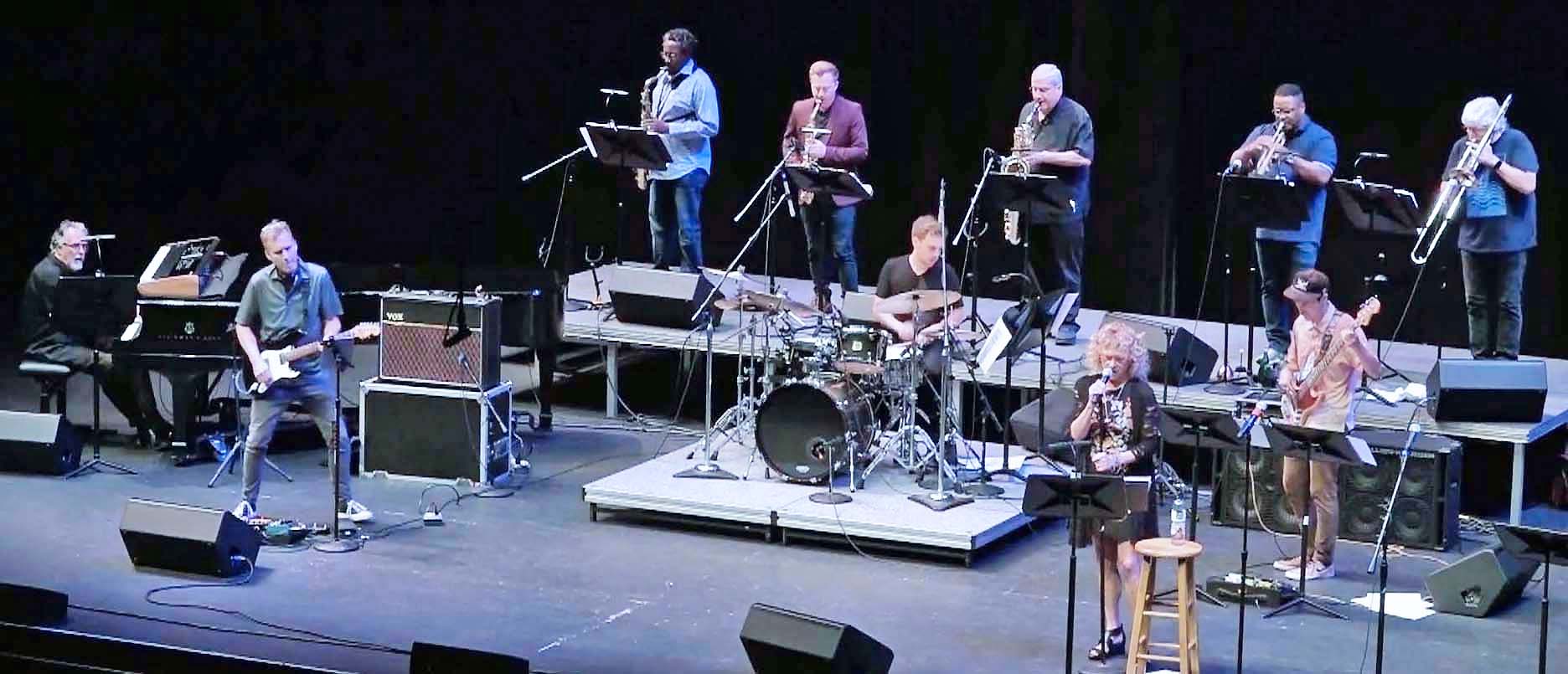ITF Jazz 2021
by Antonio J. García
ITAJ Associate Jazz Editor
 |
John Fedchock and Sara Jacovino lead a late-night jazz set. all photos |
Wednesday
Jazz’s debut in this year’s Festival came with the Wednesday Late Night Jazz session featuring trombonists John Fedchock and Sara Jacovino along with the ITF rhythm trio of Todd Simon (keyboard), Amy Shook (bass), and Todd Harrison (drums). Their opening “Invitation” served as just that, as the headliners tore into a deep trench of a groove in their rendition. The set continued with “Star Eyes,” “A Beautiful Friendship” (featuring Sara), a Latinized version of “Alone Together,” I’ve Never Been In Love Before” (featuring John), and concluded with “I’ll Remember April,” all the while sharing generous solo-space with the members of the rhythm section. Within the mix Shook’s bass-pitches unfortunately weren’t clear while the trombone played.
It was clear that the crowd was most supportive, though the avid listeners seemed to group towards the stage while the rear bar-crowd created quite a loud sonic backdrop throughout the performance. This mystifies me even in the years I attend ITF live, as that level of audience-noise would never be considered acceptable during a classical performance or at major jazz clubs; but it has become a staple of our conference. I encourage the ITA to consider transforming these late-night events more into a listening room.
I believe a pro-jam session followed this set; but if so, it was not streamed for online viewers.
Thursday
The afternoon brought an Artist Concert by John Fedchock and the house trio in the Studio Theater, starting with his uptempo composition “This Just In” (over the changes to “Just in Time”), featuring intense trading with drummer Harrison. The program continued with John’s arrangements of such standards as “East Of The Sun,” “Lament,” an Afro-Cuban spin on “Nature Boy,” “Make Someone Happy, and “You and The Night and The Music.” The time-lag of video after sound was much smaller than The Loft’s so was far less distracting from the great music-making of the program.
ITA Jazz Competition |
|
In his Artist Masterclass of the same day, John invited finalists in the J.J. Johnson Jazz Trombone Competition to perform for his supportive critiques, starting with Gregory DeAngelis (Manhattan School of Music; Marshall Gilkes, teacher), who delivered a lovely “Corcovado/Quiet Nights.” Henry Sparks (DePaul University; Tim Coffman, teacher) followed up with “I’ll Be Seeing You.” Jack Courtright (University of North Texas; Nick Finzer, teacher) finished the set with “Stablemates”; and each student received input from Fedchock and the appreciation of all present. After 39 minutes, as John answered questions from the audience, the archival videofeed abruptly ended.
The
rhythm trio returned for the Evening Concert of the ITF Jazz All-Stars,
which took place in the Festival’s primary venue, the Bill Heard Theater, and featured
John Fedchock, Sara Jacovino, Ben Patterson, and Jennifer Wharton in the first
Festival jazz offering fully synched in audio and video for online attendees.
Sara’s exciting arrangement of Jerome Kern’s “Look for the Silver Lining”
propelled the concert forward into John’s composition “Little Cupcake”
(originally composed for Sara’s ensemble “Bonegasm”), followed by her
composition “A Better Version of You” (solo bone with trio) and Ben’s own “We’re
Back, Baby!” (joined by trombonist Wes Funderburk). Fedchock calmed things down
with a solo-bone-with-trio version of the ballad “Never Let Me Go,” followed by
a Wharton-commissioned composition by Remy Le Boeuf, “Face Value,” and a solo-with-trio
delivery by Patterson of Cole Porter’s “I Love You.” The band wrapped with a
new arrangement by Fedchock of Mongo Santamaria’s “Afro Blue.” It was a
highlight of the Festival to hear this pro trombone quartet deliver the wide
range of solo and ensemble delights its instrumentation offers with such great
composer-arrangers. The sound from the main hall was mostly ideal (save
occasional moments when the soloist’s mic had not been properly recognized).
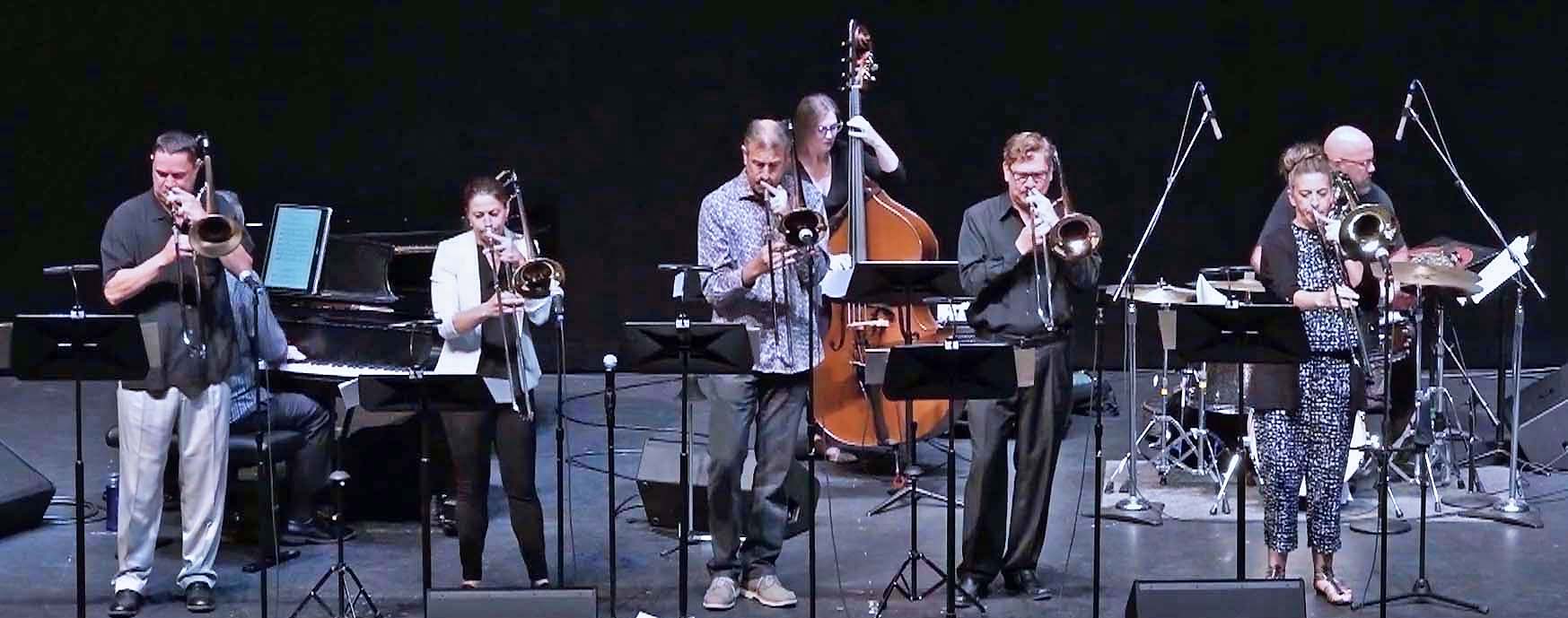 |
The ITF Thursday Jazz All-Stars united Wes Funderburk, Sara Jacovino, John Fedchock, Ben Patterson, and Jennifer Wharton. |
The day concluded with the Late Night Jazz set at The Loft featuring Nick Finzer and the house trio, who opened the set with a tribute to the recently deceased Curtis Fuller via Fuller’s composition “The Court.” Unfortunately the Loft’s audio/video un-sync continued; and as with the previous night, Shook’s bass-pitches weren’t clear while the trombone played. Ellington’s ballad “The Star-Crossed Lovers” received a pixie-plunger treatment from Nick. He then gave a shout-out to his institution’s (University of North Texas) jazz trombone ensemble, the “U-Tubes,” who had won the ITA’s Kai Winding Jazz Trombone Ensemble Competition and had thus been invited to perform on his stage that evening. With the group unable to travel due to COVID-era restrictions, Nick instead invited his UNT colleague Tony Baker to sit in on “I Wish I Knew,” followed by his student Jack Courtright (J.J. Johnson Jazz Trombone Competition finalist) on “On Green Dolphin Street.” Finzer suggested that the set end a bit early in order that the workhorse house rhythm trio would get some rest prior to its 9 a.m. rehearsal the next day; so they concluded with a rollicking rendition of Slide Hampton’s “Chop Suey/Last Minute Blues.”
Nick Finzer’s late-night |
|
|
The ITF house rhythm trio of Todd Simon (keyboard), Amy Shook (bass), and Todd Harrison (drums) |
Ben Patterson’s recital featured guitarist Shawn Purcell with the house trio. |
|
Friday
For the 10 a.m. Artist Concert that followed that 9 a.m. rehearsal in the Studio Theater, trombonist Ben Patterson was joined by not only that trio but also by guitarist Shawn Purcell, thus recreating in part the band for Patterson’s recent recording of original compositions, “Push The Limits,” which indeed was also the electrifying opener of their set of tunes from the album. “Easter Waltz” offered a calm contrast between that preceding tune and the following “Fear Is The Mind-Killer.” His piece “Almost There” shifted between 3/4, 5/4, and other metric accents, leading to the 4/4 pocket-shuffle “Scoish” (inspired by guitarist John Scofield).
|
ITA Jazz Competition |
Early afternoon brought the excitement of younger talent at The Loft: the ITA Competition Final Rounds. The Carl Fontana Jazz Trombone Competition (sponsored by XO Professional Brass) presented finalists Maarten Combrink (Conservatory of Amsterdam; Ilja Reijngoud, teacher); Wyatt Forhan (Michigan State University; Michael Dease, teacher); and Ian Kaufman (Temple University; John Swana, teacher); while the J.J. Johnson Jazz Trombone Competition (sponsored by Michael Rath Trombones) offered finalists Jack Courtright (University of North Texas; Nick Finzer, teacher); Gregory DeAngelis (Manhattan School of Music; Marshall Gilkes, teacher); and Henry Sparks (DePaul University; Tim Coffman, teacher). During the rounds the performers were not identified by name so as to maximize anonymity to the judges (who presumably had not already seen the online PDF program with names included). Most delightfully, the synchronization issues of the preceding Loft events were nowhere to be found; and viewers such as I were treated to the feeling of almost being present in the club.
First up was the Fontana playoff. Finalist #1, on prerecorded video, performed “I Thought About You,” a blues, and a plunger-muted “Isfahan.” Archival viewers such as I heard the quartet’s sound as patched through The Loft’s sound system rather than via a direct feed, a slight disadvantage. Finalist #2 played “Stardust,” “If I Only Had A Brain” in samba style, and “Sandu” live, as did Finalist #3, playing “Passport,” “Dedicated to You,” and “A Beautiful Friendship.”
After a set-break to allow the judges to confer, the evening continued with the Johnson playoff. Finalist #1 opened with J.J.’s “Boneology,” followed by a medium-slow pocket-blues version of Curtis Fuller’s originally brisk “Transportation Blues” and the finalist’s own samba composition, “Not It.” Finalist #2 offered J.J.’s “Judy,” the finalist’s own “All Good Things,” and Chick Corea’s “Matrix.” Finalist #3 concluded the set with “Blues on the Corner,” his own lovely ballad “Unbecoming,” and J.J.’s contrafact on “What Is This Thing Called Love”: “Flat Black,” completing a nearly two-hour gathering at The Loft.
As at each ITF, it is so inspiring to hear the up-and-coming talents emerging in these events. That night at the Legacy Hall concert, the winners were announced: Maarten Combrink (Fontana) and Jack Courtright (Johnson). As it turned out, Cumbrink had been the one virtual contestant. The future of jazz trombone is in good hands, and we salute all six finalists for their musicianship and creativity!
Dr. Emmett C. Goods |
|
Friday continued with a Presenter Lecture from Dr. Emmett C. Goods, “The Trombone in the Hard Bop Era,” in which he focused on the four trombonists he had identified as defining the genre between 1955-1964: Curtis Fuller, Locksley “Slide” Hampton, Julian Priester, and Grachan Moncur III. This seemed to be the only historical, research-based jazz workshop of the ITF (unless I missed one); and it would be helpful to include more in the future.
|
Jennifer Wharton's recital. |
Jennifer Wharton’s Recital, “New Music for Trombone Ensemble,” focused on her own compositions and arrangements for duets to choir, with and without the house rhythm section in the Studio Theater. With such collaborators as Tony Baker, Justin Cook, John Fedchock, Nick Finzer, Sara Jacovino, Joseph Jefferson, Javier Stuppard, and Chris van Hof, the bass trombonist presented originals “Virtual Reality” (arranged by Fedchock) and “Minor Victory,” plus arrangements by John or her of Dick Oatts’ “Anita” and “The Tailor,” Carmen Staaf’s “Manta Rays,” and Cynthia Erivo and Joshuah Brian Campbell’s “Stand Up.” As with the earlier concert by the ITF Jazz All-Stars, it was superb to hear the trombone family making ensemble music together in various combinations.
Late Night Jazz (and a minor lag in video-sync) returned to The Loft on Friday night, featuring Ben Patterson with the house trio and guitarist Shawn Purcell, performing “Alternate Reality” from Ben’s latest album as the opener, followed by “Missing Michael” (a tribute to the late Michael Brecker), which will appear on his next recording, as might the funky “Here Now” (or “Hear Now”) that followed. While the crowd at the bar rivalled in sound, the band continued with an original samba and concluded with “FLT,” a “Funky Little Tune.” I got the sense that a late-night jam session would follow; but if it were so, it was not archived.
Ben Patterson leads his combo in a late-night concert. |
|
Sara Jacovino in recital (with Amy Shook, bass) |
|
Saturday
By the last morning of the Festival, attendees are known to be a bit worn out; and so it fell to the 10 a.m. Artist Concert of Sara Jacovino in the Studio Theater to stir up the jazz crowd. And assisted by the house trio, she did just that, performing selections from her original, programmatic jazz suite Everyday NYC and bringing the attendees quickly to enthusiasm. With motives that reappeared periodically within the movements, the suite held together beautifully even as she chose to perform segments out of their original order. The set conveyed a slight video-lag to the virtual audience, though not major. Perhaps more than any other performance, this concert displayed the virtuosity of the ITF rhythm trio of Todd Simon (keyboard), Amy Shook (bass), and Todd Harrison (drums) as they navigated the wide terrain Jacovino had created for them.
An additional jazz clinic had been listed. Perhaps because it had been presented via Zoom and for the Youth Workshop, however, the afternoon’s Nick Finzer clinic (also co-credited with Sean Reusch) was not available archivally.
|
Steve Wiest (upper right) leads Vinyl Hampdin in concert. |
The Saturday closing Evening Concert brought ITF the closest thing to a rock horn-band as it has featured since Bonerama: Steve Wiest’s latest creation, “Vinyl Hampdin” (pronounced “Vy-o-nel” as if patterned after a certain legendary jazz trombonist’s name). I noted that early in the broadcast the video-lag after the sound was significant; but thankfully, it repaired soon after. The band features vocalist Lisa Dodd Watts with trumpet, three saxes, trombone, and four rhythm. As chief arranger, Steve wore his colors on his sleeve, issuing covers on tunes by Rare Earth, Stevie Wonder, The Kinks, Paul McCartney, Bill Withers, and more, plus his original “Walk Star.” A rare trip to the 1934 cabinets of composer Harry Warren and lyricist Al Dubin was justified when “I Only Have Eyes for You” took on the band’s slower-than-The Flamingos’ sassy tempo. The ensemble’s debut album was titled “Red”; their next is “Blue”: watch for them! The new release likely won’t include the orchestral trombone-choir medley Wiest inserted briefly towards the end of “Use Me” in this performance, but the album will rock no less for that absence.
There’s More!
Jazz was of course present within portions of some other ITF events, such as in the electronic effects-laden “Industrial Devolution” of composer Mark Hetzler performed by Chris Van Hof and Evan Conroy within their Make More Noise Trombone Duo recital. The ITF Composers Workshop Showcase included a composition by E.J. Donkin titled “Bop,” a piece that begins in a shuffle groove; but alas, video of her piece as performed by Deb Scott was lost before archiving. The Insanity Brass Duo of Micah Everett and Michael Wilkinson on myriad horns offered jazz-influenced compositions by Wilkinson, Michael Davis, and Tommy Pederson. The Iowa State University’s CySlides trombone ensemble of students performed Sammy Nestico. And in the University Faculty Showcase Recital #2, the duo of Drs. Nathan Dishman and Cory Mixdorf performed my own Three for Two (or One or Three).
The Online Experience
I’ve been asked to comment regarding the experience of attending the ITF online. Due to my own schedule, I had been unable to attend the 2021 ITF in person or synchronously: all my attendance was via the Whova app weeks after the Festival had concluded. Though I sampled the event briefly on my cellphone, I primarily indulged in my 2020 MacBook Pro (operating OS 11.4 Big Sur), from which it was easier to link to my larger monitor and external speakers for a more immersive experience.
I quickly found event programs, session handouts, and official photos under Resources, plus links there to Facebook, Instagram, Logistics (for on-site attendees), Polls (the questions, but not a summary of their answers), and more. A category called Leaderboard encouraged attendees to be more active in sharing input with others via the app, tabulating in real time a point-score that at this writing showed Lindsey Smith as having topped the board. I could access 16 exhibitors, see the 99 photos posted to the Whova app by participants, read the hundreds of interactive postings, examine the profiles of some 800 virtual or in-person attendees (and have options to say hi or perhaps videocall them), and read bios on the session presenters and concert performers.
The most important locale for most online participants would be the Video Gallery, which at my viewing included 96 videos—far more experiences than of course I would have been able to attend in person over the four live days of the Festival. These were also accessible from the Agenda area, which provided a search/filter engine specifying a dozen possible categories, plus the ability to create one’s own agenda of sessions to view. Within the Documents area of Resources, the Agenda Handouts portion included nearly 90 downloadable concert programs/session handouts.
There were a few quirks to Whova’s setup:
- The Agenda offered a clickable move from events of Wednesday to Thursday to Friday to Saturday; however, clicking on the four choices during my post-Festival visits did not effect any change in the viewed listings.
- Because of that, a search for “jazz” revealed very few offerings; so I had to search manually for almost every event I’ve described above.
- If you accessed a session video via the Agenda listings, you could download any available handouts; but if you viewed the video solely via the Video Gallery, the handouts were not linked there.
- If you utilized the Agenda listings to access a concert or session, there was no way to do so in a new tab. If you remembered to back-arrow when the session was over, you were led promptly to where you’d left off in the Agenda schedule. But if you’d forgotten to back-arrow and instead had closed the video’s window, you had to navigate your own way from scratch to the Agenda and then to what you’d next sought within it.
- The “Trombone TV Stream” clearly had been a live-only tool not intended for archival viewing. Clicking it brought me to various unlabeled performances in whole or very small part; so these editions would best have been hidden from view following conclusion of the live Festival so as to limit the confusion of archival viewers.
These would be areas for improvement in a future year but are relatively small issues compared to the outstanding opportunity to experience so many concerts and workshops during and for over a month following the Festival.
Outside of Whova’s domain, the ITA apparently did not publish any PDF of an overall program for the Festival that in-person or remote attendees might have been able to reference for guidance (especially given that the Agenda listings did not effectively navigate, as noted above). This would be a welcome addition for the future, as some events I had to stumble on by accident when combing through the 90+ videos archived. My apologies here go to any artist whose jazz session I did not discover!
Of greater musical significance for jazz fans was simply the poor synchronization of sound and image from the remote site of The Loft during much of the Festival, central to the ITF jazz experience. I can empathize and expect this is not Whova’s doing but simply the challenge of livestreaming out of various locales, as so many of us have learned since the lockdown of March 2020. While the ITF’s classical venues were closely in sync, The Loft performances were often distractingly separated in sound and sight. As initial example of the latter, the Wednesday Late Night Jazz session featuring trombonists John Fedchock and Sara Jacovino plus ITF rhythm trio was broadcast with the images a full quarter-note behind the sound (if clocked within the opening tune, “Invitation”) and archived as such. For the best archival experience thereafter, ITA volunteers would have to import such videos into video-editing software and tug the elements of audio and video into proper sync; then export that result; and re-load it onto the Whova site—not easily accomplished by any volunteer team with an external life to live!
That highly swinging set was partially marred for online viewers during the first nine minutes by transmission only on the left channel of the stereo presentation, as well as in a mix that conveyed none of Shook’s bass-pitches when the trombonists were soloing (though she could be heard more clearly sans bones). Such are the challenges of livestreaming the first day on the fly, especially from an off-site locale (The Loft), though the bass-frequencies remained an issue in some later Loft concerts.
There also seemed to be a high-definition camera available for closeups of the left half of The Loft’s stage but typically not of the right; so featured artist Ben Patterson, for example, was regularly in less focus than his guitarist and keyboardist. Again, this was an apparent limitation of the site and/or ITA resources, not of Whova functionality.
The distracted listener’s work-around for the above, of course, was simply to ignore some of the visuals and focus exclusively on the great music which, after the initial Wednesday night stream, seemed to improve substantially in sound-broadcast quality. But we know that synched visuals afford attendees the opportunity to observe proper technique of playing the trombone (and other instruments); so a lack of synchronization does diminish the educational value of a visual performance.
Staffing and/or funding may have caused the lack of broadcast of the late-night pro-jam sessions I presume occurred; solving this would be a plus for remote attendees.
Finally for the asynchronous remote-attendee, the absence of the no-doubt superb clinics originally presented via Zoom—whether by a Joe Alessi or a Nick Finzer—represented a proportional loss as well.
The Joy of Community
Certainly the jazz portion of the ITF was a strong success, inspiring and informing attendees throughout. And to be clear, the listed concerns above did not outweigh the incredible value of attending the ITF remotely, even asynchronously. I was continually inspired and informed, but I also felt an unshakeable sense of being actively present within the trombone community.
For accomplishing that—despite the challenges of time, place, and COVID-19—I salute the International Trombone Association, its Festival staff and volunteers, Whova, the Festival performers and presenters, and the live attendees. The ITF is an event that should be shared globally with live and remote participants, and the 2021 conference successfully broke technical ground towards broadening its outreach in ways that will prove even more effective in the future.

